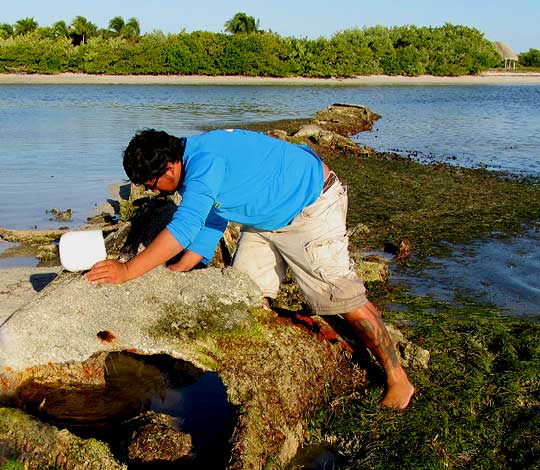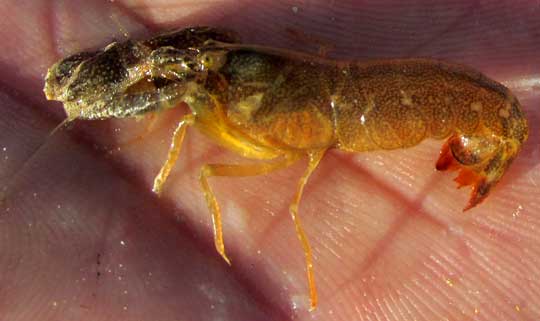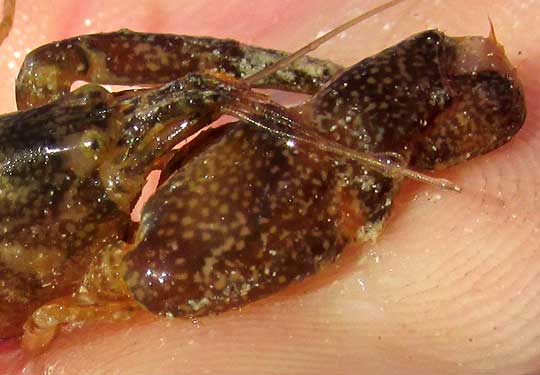Excerpts from Jim Conrad's
Naturalist Newsletter

from the March 1, 2015 Newsletter issued from Río Lagartos, on the Yucatan Peninsula's northern coast (~N21.60°, ~W88.16°), Yucatán state, MÉXICO
SNAPPING SHRIMP
During a very low tide, Rayo and I waded at the edge of a shallowly submerged prairie of Shoalgrass, among the remains of an abandoned, metal pipeline about thigh-high, normally underwater. Mostly eroded away, the pipeline formed a long, seaweed- and barnacle-encrusted sort of bathtub. It was left over from the days of cutting and dredging the canal through the narrow finger of land separating Ría Lagartos Estuary from the Gulf of Mexico, in front of the town of Río Lagartos. In this rock-poor, sedimentary environment, it attracted an untold diversity of aquatic organisms needing a stable substrate on which to anchor. Below, you can see Rayo exploring the decaying pipeline:

You've already been introduced to several organisms found in this accidental diversity hot-spot, the Sargassum Fish and the octopus among them. That day, one of the most attention-getting in the area was the pencil-thin little crawfish-like crustacean shown at the top of this page. A side view showing how the tail curls under, shrimp-like, is shown below:

That little being doesn't look like it would draw attention, except maybe for its larger claw, which seems somehow deformed and useless. A closer look at the weirdly shaped large claw is provided below:

It turned out that the big claw isn't deformed at all, but rather is one of the most remarkable adaptations found in the animal world. For, that claw is used by the shrimp to make a kind of snap that is so powerful that the percussive impact of the snap's shock wave traveling through water can stun or kill small, nearby fish or other prey. The shrimp doesn't use the big claw to grab prey, but to "shoot" it with a shock wave.
That day, as we wandered along the old pipeline's length, we were accompanied by an ongoing series of snapping sounds, averaging maybe every 15 seconds. Unable to see the snapping being made, I wondered whether all of them were used to stun prey, or were some or all of them being used to warn others of the species to stay out of the snapper's territory, or maybe the snapping served in courtship, the notion being that the more powerful the snap, the more robust the potential mate.
I'd never heard of this kind of thing but a little Internet sleuthing turned up a whole new part of the animal kingdom to explore. Our critter is a snapping shrimp, a member of the Snapping Shrimp Family, the Alpheidae, which is of worldwide distribution and embraces about 600 species in 38 or more genera. Most snapping shrimps dig burrows and are common inhabitants of coral reefs, submerged seagrass flats like ours, and oyster reefs, mostly in tropical and temperate coastal and marine waters.
Of the world's 600 species, about 70 are listed for waters of the Gulf of Mexico and even more occur in the Caribbean. Luckily, on the Internet there's a freely downloadable 2012 treatment of the group of snapping shrimp species to which our shrimp seems to belong, Arthur Anker's "Revision of the western Atlantic members of the Alpheus armillatus species H. Milne Edwards, 1837 species complex (Decapoda, Alpheidae), with description of seven new species."
That well illustrated revision indicates that our snapping shrimp probably is ALPHEUS CARLAE, found in the Caribbean but not most of the Gulf of Mexico, occurring from Florida south to South America and southern Brazil. Anker describes its habitat as shallow, protected bays and lagoons, on fine sand and silt, close to mangroves or seagrass beds, which is exactly where we found our individual.
The knock-out snap produced by snapping shrimp fascinates scientists, one reason being that snapping shrimp snaps are a major source of noise in the ocean, even sometimes interfering with SONAR navigation. Technically the snap is said to result from the collapse of a "cavitation bubble" produced by the modified claw. The term cavitation applies to the formation of a partial vacuum in a liquid by a swiftly moving solid body. Studies show that snapping shrimp snaps are so intense that light is emitted.